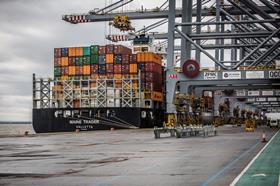
London Gateway is built for scale. Located on over 200ha of reclaimed marshland at the mouth of the Thames, the site combines the UK’s largest deep-sea port with a nine million sq ft logistics park, as well as housing what is described as the country’s biggest railhead.
It has a seemingly unlimited list of records, which are expertly reeled off by senior supply chain manager and maritime industry veteran Andy Browning. “London Gateway is Europe’s first manmade port, which is very unique,” he says. “It has happened in Asia but not in Europe. Ports have always grown organically so they tend to be awkward shapes. We’re a straight line on the river, and when complete there will be room for seven vessels on the quay,” he explains during a tour of the site, which is 50 per cent complete and £1.5 billion into a total pot of £2bn.
The port receives 22 sailings a week from the world’s biggest ships and handles 80 per cent of all the UK’s imports from Latin America, as well as services from Australasia and South Africa, routes that are dominated by the fresh produce trade, says Browning. Automation is a priority, with most equipment on site having an automated option that can be employed as operations move further away from manual labour. This means the port’s productivity is very high, says Browning, as well as protecting it during bad weather – in the four years it’s been open, London Gateway has closed for only four hours, compared to the occasionally unpredictable impact on other ports.
Speed of access and mobility across the site is something everyone associated with London Gateway is keen to flag up. Gavin Knight, managing director of new produce business Halo, which has chosen London Gateway as its new home, points to the entrance to the port: “2,000 containers a day go through that road, and the beauty of it is you never see a traffic jam.”
Lorries arriving at the port have a uniquely uninterrupted route to the quayside. They drive through automated scanning points that check containers, driver registration number and vehicle number through a series of photographs, which automatically reconcile and confirm an online booking. Automated cranes pick the container off the truck, delivering it to the loading bay, where enormous loading cranes operated by manual labour can select two at a time to load or unload onto ships.
At the port’s integrated logistics park, warehouse space has planning permission for almost 10m sq ft, with sites ranging from 1.5 million to the 110,000 sq ft signed for by Halo, while other tenants include service company UPS, Lidl, and Dixons Carphone Warehouse. Halo has an exclusivity agreement with the site to prevent any other chilled food company signing within a year after it is up and running, but Knight says another barrier for others might be the costs. Halo will invest around £10m in total, he says, with a large percentage of those costs required up front alongside a 15-year lease.
With almost 30 years in the fresh produce industry, Knight is passionate about the opportunity to remove road miles, and cost, from the supply chain through a lean packing operation such as Halo. He says the business will be able to save 80-90 per cent of the inbound logistics costs of a consignment, and will be more cost effective than packing in Kent due to redistribution rates that are as competitive as Spalding. As well as positioning itself for long-distance Latin American and other southern hemisphere trade, Knight says Halo will also be able to compete for northern hemisphere business by receiving shipments from other south coast ports. The facility, due to be operational by the start of next year’s southern hemisphere imports season, will have six chill and three frozen chambers, as well as a range of added-value options such as ripening and grading.
“There’s a lot of interest from UK multiples and wholesalers. We’re close to the London markets, and a vehicle going to Spalding costs around £350 whereas coming here will be 10 per cent of that,” he says. Large growers from major global producer countries are another likely customer base, he believes. “We are seeing a groundswell movement for big grower groups and co-operatives who want a representative in the UK, rather than relying on an external importer,” he says.
Knight has a long history of overseeing start-ups in produce service provision, most recently with ISS, a DPS-Fowler Welch joint venture that became linked to Tesco as its major customer. But this time, Knight says Halo will remain multi-customer focused. “What we want is to be independent, we will stay in service provision so we aren’t a threat to any of our customers,” he says. “As soon as you go into trading or marketing you threaten their business.”
The mood at both Halo and London Gateway is one of anticipation and of growth, and while it’s still early days, it’s a boost to see fresh produce at the centre of one of the biggest investments in infrastructure and trade.



